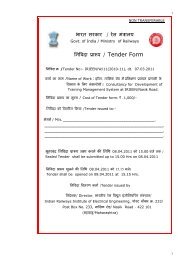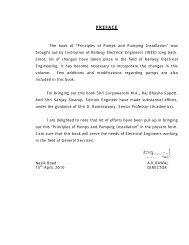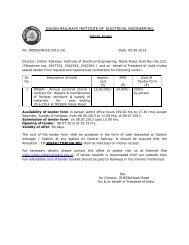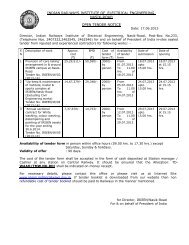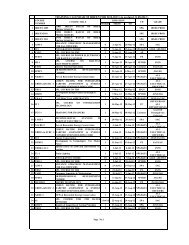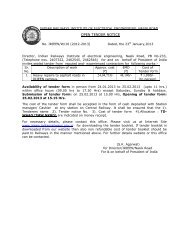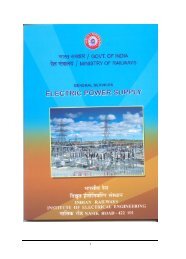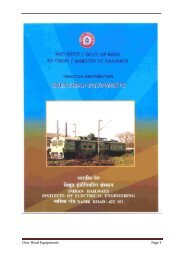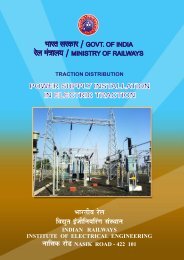Traction Rolling Stock - Indian Railways Institute of Electrical ...
Traction Rolling Stock - Indian Railways Institute of Electrical ...
Traction Rolling Stock - Indian Railways Institute of Electrical ...
You also want an ePaper? Increase the reach of your titles
YUMPU automatically turns print PDFs into web optimized ePapers that Google loves.
7.2 DUAL BRAKE SYSTEM ON ELECTRIC LOCOMOTIVES<br />
WAG/5 and WAP/1 & 3 locomotives manufactured at CLW are fitted with twin pipe dual<br />
brake system. Railway have also converted some WAM/4, WCG/2, locomotive to twin pipe dual<br />
brake system. Dual brake system is designed for hauling stock equipped with either graduated<br />
release type single pipe or twin pipe air brakes or vacuum brakes.<br />
Simple schematic diagram explaining the principle <strong>of</strong> operation working <strong>of</strong> dual brake<br />
system, vacuum brake system and charging <strong>of</strong> main reservoir is attached as<br />
Fig.<br />
7.2.1,7.2.3,7.2.4,7.2.5.<br />
7.2.1 Description <strong>of</strong> the brake system<br />
The main features <strong>of</strong> the system as fitted on these locos are-<br />
a) Self lapping type independent brakes on the locomotive, i.e. the brakes on locos<br />
can be applied and released in steps with pressure maintaining feature in all<br />
positions.<br />
b) Braking <strong>of</strong> air braked passenger/freight trailing stock and at the same time<br />
proportional brake application on locomotive through distributor valve.<br />
c) Braking <strong>of</strong> air brake passenger/freight trailing stock fitted with graduated<br />
release type <strong>of</strong> brake equipment and at the same time proportional brake<br />
application on locomotive through distributor valve.<br />
d) Dynamic brake interlock to prevent simultaneous application <strong>of</strong> automatic air<br />
brakes and dynamic brakes on loco. Automatic application <strong>of</strong> emergency<br />
brakes on loco and trailing stock in case <strong>of</strong> failure <strong>of</strong> dynamic brakes.<br />
e) Multiple unit operations with locos fitted with similar type <strong>of</strong> brake system.<br />
f) In an emergency, brake pipe and vacuum train pipe can be directly vented<br />
simultaneously by the emergency brake valve provided in front <strong>of</strong> assistant<br />
driver's seat.<br />
g) Loco brakes can be released independent <strong>of</strong> the train brakes.<br />
h) Provision for freight/passenger changeover cocks to regulate locomotive air<br />
brake application timings depending upon the type <strong>of</strong> stock to be operated by<br />
locomotive.<br />
i) Provision for the driver to apply independent brakes on leading loco in MU<br />
operation in case <strong>of</strong> parting between locomotives.<br />
j) In case <strong>of</strong> very heavy leakage in the feed pipe or failure <strong>of</strong> feed pipe inter<br />
coupling equipment, twin pipe brake system on trailing stock can be worked as<br />
single pipe system by simply isolating the feed pipe <strong>of</strong> trailing stock from<br />
locomotives.<br />
k) Power cut <strong>of</strong>f during emergency brake application.<br />
l) Visual indication on driver's cab through air flow indicator device during train<br />
parting, alarm chain pulling or Guard's emergency brake valve operation or<br />
loco parting while hauling air braked stock.




